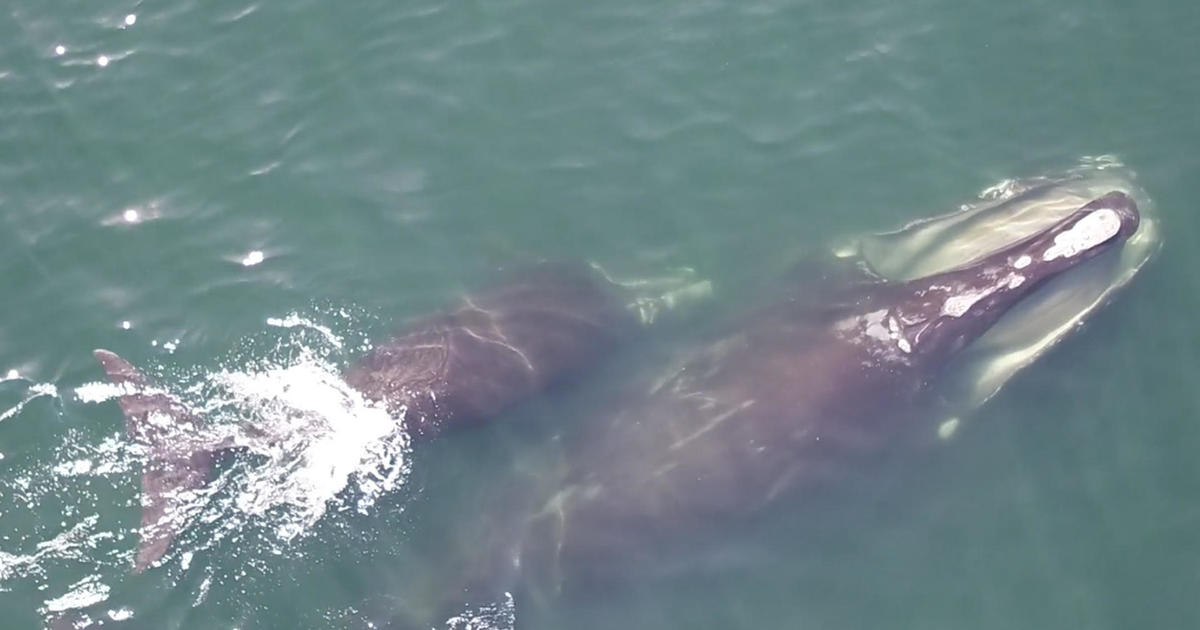New Hampshire Sees Surge In Nesting Bald Eagles
Hinsdale, N.H. (AP) — Amid the sounds of chirping warblers and the rumbling of a nearby backhoe, biologist Chris Martin trudged up an abandoned railroad track until he reached a ridge overlooking the Connecticut River, a dam and the closed Vermont Yankee nuclear power plant.
Scanning the New Hampshire sky, Martin spotted what he has come for: a pair of bald eagles that have built a massive nest atop a white pine tree.
The female was on the nest and her mate was perched on nearby tree, before flying off across the river separating New Hampshire and Vermont. As Martin looked through a pair of binoculars, he concluded there might be eagle chicks in the nest, though they were not visible.
"This is cool," said Martin, who works for the New Hampshire Audubon and has been coming to this site for 15 years, also home to peregrine falcon and osprey nests. "The bird is sitting in an upright posture, which is another clue that the chicks have hatched. A grey, fuzzy chick could pop up at any time."
Such sightings are the latest sign that bald eagles are on the way back in both states.
This year has been especially good year for the birds in New Hampshire. So far, 39 eagle nests with incubating eggs have been identified. That is a 30 percent increase from last year and a dramatic rise from the 1990s, when the state only had one nesting pair. Vermont, the last of the lower 48 states to get a successful nesting pair in 2008, is likely to see an increase from the 15 nests identified last year, although they are still finalizing their numbers.
"Eagles are thriving. The population recovery is robust, to the say the least," said Martin, who works with a team of volunteers and the New Hampshire Fish and Game Department on eagle conservation efforts that include surveys of nest sites and numbers of young, as well as efforts to protect them from predators like raccoons and managing their nests on private property.
The eagle's resurgence in the region is part of a broader recovery nationwide that has been hailed as a great conservation success story. Once reduced to a few hundred pairs because of DDT and other pollutants, they were one of the first species to be added to the Endangered Species List in 1967. They were delisted in 2007, and there are now 10,000 nesting pairs nationwide, according to the U.S. Fish and Wildlife Service.
They have even become commonplace in the New Hampshire capital of Concord and in New York City, which saw its first nesting pair in a century last year. A pair of baby bald eagles became minor celebrities in April after they were born at the U.S. National Arboretum in Washington, D.C. A naming contest on social media ensued, and they have since been named "Freedom and "Liberty."
"They have increased substantially. We can see that everywhere," said Al Cecere, the president and founder of the American Eagle Foundation. "Florida and Minnesota have over 1,000 pairs. They are increasing especially where there are large bodies of water."
That is the case in New Hampshire and Vermont, where the Connecticut River Watershed has proven ideal habitat for the birds, which feed on everything from fish to road kill and nest hundreds of feet up in trees on the edge of rivers and lakes. In the early days of the recovery, many birds were expanding their ranges from Maine, New York and Massachusetts. Their offspring have since established their own territories in the two states — going from a pair every 30 miles on the Connecticut River to one every few miles. They often can be seen perched near the roadside or soaring over lakes.
"We have abundant habitat in Vermont, so now it's time for the eagles to find all of that and for us humans to give the eagles some space so they can be successful," John Buck, a wildlife biologist with the Vermont Fish and Wildlife Department, said.
But threats remain for these iconic birds — especially since they live in such close proximity to humans. Still listed as threatened in New Hampshire and endangered in Vermont, eagles are losing habitat to lakeshore development, especially on islands, killed in the thousands nationwide by wind turbines, and even sickened from ingesting lead from old fishing gear and ammunition. Two bad winters in Vermont saw their numbers drop dramatically a few years back.
For Martin, the threats are best illustrated when he comes upon an empty nest, as he did recently at one 100 feet up atop a dead white pine tree in Dummerston, Vermont, across the river from New Hampshire. Expecting to see a pair nurturing their chicks, he found an empty nest of sticks. A search up and down the Connecticut River found no trace of the birds, leaving him concerned.
"The nest looks abandoned," he said, adding there was a pair incubating eggs as recently as April. "There could be all kinds of possibilities. We may have lost an adult bird. In that case, it's tough for one bird to keep the chicks warm and safe and get food for them."
Copyright 2016 The Associated Press. All rights reserved. This material may not be published, broadcast, rewritten or redistributed.



